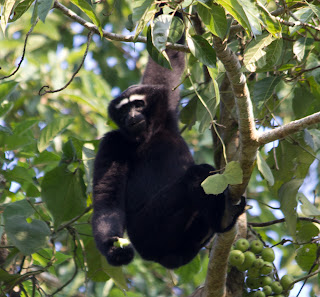From the house we had already seen Herring Gull, huge flocks of Lapwing, Starling, Raven (feeding on a nearby sheep carcass), and Wood Pigeon. In the garden around the feeders we had Siskin, Blackbird, Goldfinch, Greenfinch, Chaffinch, Wren and Great Spotted Woodpecker.
 |
| Brents looking for landing space |
We started out at Penrhos where there were Black-headed Gulls on the pond, along with Mallard, Coot and some rather dodgy ducks. In the nearby woodland there were Robin, Blue Tit, Great Tit, and on a feeder near the burger truck a Coal Tit was also seen. We were waiting for the tide to recede to reveal some of the Brent Geese feeding grounds, but by the time we had returned to the coast, the birds were still swimming waiting for food to appear. We looked for Mediterranean Gull whilst we waited, but no luck so far.
 |
| Brents with Curlew |
Some local bird watchers got us on a Slavonian Grebe which was way off in the distance. As we scanned the bay there were also Great Crested Grebe and Red-breasted Merganser. By now the tide had receded a little and Oystercatcher had joined the other waders on the shoreline. The Geese were gradually moving across our line of view and slightly nearer, enabling us to confirm some of our earlier colour-ring readings.
 |
| The Skerries |
All the birds flew up at one stage, spooked by a Merlin which shot through - needless to say Turnstone and Redshank noticed it far earlier than we did, but then it is life and death for them!
At Holyhead Harbour we had four female and two male Red-Breasted Mergansers and a Black Guillemot, but little else.
The afternoon was spent at Cemlyn, a windy spot looking out towards The Skerries, which showed well in the short bursts of sunlight we had. The find of the day came here however, in the form of a wintering Whimbrel. Perched on top of the rocks along the shoreline it showed well until we tried to photograph it - then it disappeared against the rocks, its plumage camouflaged well.
 |
| Whimrel - a dot in the distance! |
Inland there were Collared Dove, Rock Dove Dunnock, Song Thrush, many more Raven
In the pools just inland of the coast we had Pintail, Mallard, Shoveler, Grey Heron and Coot.
On the way home we took a detour (or two) inland and added Greylag Geese to our day's tally. In all we had around 66 species, a pleasing total for a cold and windy December day.











































